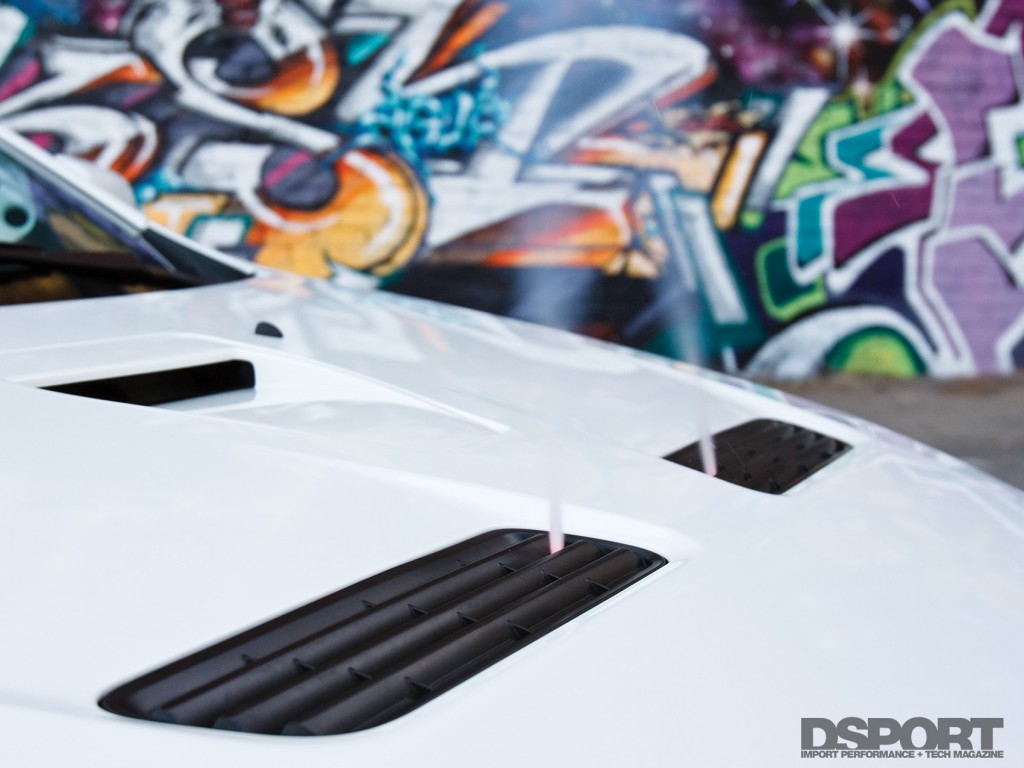Better Safe Than Sorry
If you want to have a good nitrous-oxide system experience, there are some considerations you can make to increase the chances of driving away with a smile.
Nitrous-Oxide Blow-down Tube
Unless your nitrous-oxide bottle is mounted in a trunk compartment completely separated from the driver’s compartment, you need to install a nitrous blow-down tube that vents the bottle’s relief valve to the outside of the vehicle.
Nitrous-Oxide Injection and RPM
Some OEM rev limiters work by shutting off the fuel injectors at redline. With many nitrous-oxide systems, this can be a dangerous scenario if the nitrous-oxide system is engaged when the rev-limiter is activated. Activation of the nitrous-oxide system at too low of an engine speed (below 3,000 RPM) can also result in detrimental engine damage. To prevent these occurrences, an RPM window-type activated switch can make sure that the nitrous-oxide system only operates within a minimum and maximum RPM level. Set the maximum RPM level about 200 RPM before the rev limiter.
Purge Systems
A purge solenoid can be added to most nitrous systems. This system can be helpful in obtaining more consistent performance from run to run with a nitrous-oxide system.
Fuel System
Since a nitrous-oxide system relies on the fuel system, it is always best to ensure that your fuel system is at its peak efficiency. Factory fuel-filters can begin to degrade in performance after as little as 10,000 miles of use. When installing a new nitrous-oxide system, it is recommended that you replace your factory fuel filter and be sure that the injectors are clean.
Fuel Quality
Fuel quality also plays a role in performance and reliability. Typically, four-cylinder applications jetted up to 75 horsepower and six-cylinder applications jetted up to 100 horsepower can be very reliable with the highest-octane unleaded fuel you can buy at the pump. However, an extra measure of reliability can be obtained by running higher octane racing fuels. Unleaded racing fuels are highly recommended for street applications as they do not reduce the life of the oxygen gas sensor(s) in the vehicle.
Selecting the proper nitrous jetting for a specific engine setup will help you achieve your desired horsepower level.
Ignition System
A factory ignition system is designed to operate at near factory horsepower levels. An engine equipped with a nitrous-oxide system can easily exceed the capabilities of a stock ignition system. Be sure that the spark plugs are new and that the ignition cables are in good condition. Some nitrous-oxide system manufacturers do not recommend platinum-type plugs. The cap and rotor should also be inspected on non-direct-ignition- system (non-DIS) cars. An ignition amplifier, high-performance ignition wires and sparks plugs that are one-to-two heat ranges cooler (for applications over 50hp) are also highly recommended. In the absence of an ignition amplifier, it’s a good idea to tighten your spark plug gap by .010″ to .005″. This will make it easier for your ignition to generate a spark even in the high-horsepower, nitrous-oxide enhanced combustion chamber.
Bottle Pressure
Nitrous-oxide systems are designed to deliver the correct ratio of nitrous to fuel within a certain range of bottle pressure. Most dry-systems are self-adjusting to reduce the amount of fuel delivered as nitrous bottle pressure drops. However, with wet systems, low bottle pressures can result in too much fuel and not enough nitrous oxide being injected into the engine. A bottle-heater system can heat the bottle until the pressure of the nitrous oxide is within the desired operating range. However, do not make the lethal mistake of heating a nitrous-oxide bottle with a torch in an attempt to maximize nitrous pressure. The intense heat of a torch flame anneals the aluminum, effectively weakening the bottle and making it into a grenade waiting to explode. Stories of bottle failures due to heating with a torch have ended with bottle explosions and lost limbs. In addition, bottle recertification must be done every five years.
The Bottom Line
“Squeeze”, “Spray” or “Juice,” call it what you like. It’s been called “cheating”, “horsepower in a bottle” and “the best bang for the buck power adder on the planet.” Nitrous-oxide injection is an often misunderstood technology. As a result, the misuse of nitrous-oxide injection has resulted in a plethora of horror stories. While the proper installation and application of nitrous-oxide systems delivers significant reliable horsepower gains, the horror stories should serve as a reminder that nitrous-oxide systems shouldn’t be taken lightly. When you decide to experience the rush of power that a nitrous oxide system can deliver, be sure to take the time to read through all of the instructions before you start the installation. A proper installation and proper jetting will mean that you’ll only have to worry about keeping the bottle filled.

Now Read our 201 Nitrous Guide to Advanced Nitrous Oxide




